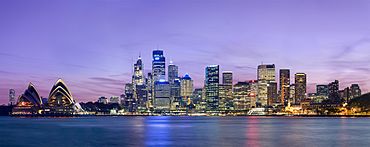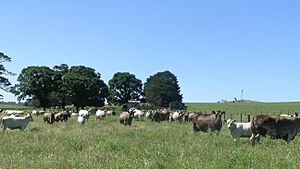Economy of New South Wales facts for kids
The economy of New South Wales represents a significant proportion of the Australian economy. The economy was valued at $557.9 billion in 2016–17, representing 33.0% of Australia's total GDP.

The Sydney Opera House and CBD at dusk from Jeffrey Street, Kirribilli in December 2008.
|
|
| Currency | Australian Dollar (A$ or AUD) |
|---|---|
| 1 July - 30 June | |
| Statistics | |
| GDP | A$557.9 billion - 2016/17 |
|
GDP growth
|
2.9% (2016-17) |
|
GDP per capita
|
A$67,841 (2016/17) |
| Unemployment | 4.6% (December 2017) |
|
Main industries
|
Services, mining, industrial and transportation equipment, food processing, chemicals, steel |
| External | |
| Exports | A$60.4 billion (2008-2009) [1] |
|
Export goods
|
coal, Aluminium, Refined petroleum, Copper ores & concentrates, Medicaments (incl veterinary), iron ore, wheat, machinery and transport equipment |
|
Main export partners
|
|
| Imports | A$100.8 billion (2008-2009) |
|
Import goods
|
Medicaments (incl veterinary), Telecom equipment & parts, Passenger motor vehicles, Crude petroleum, Computers, Refined petroleum, Monitors, projectors & TVs, Office machines, Goods vehicles, Medical instruments (incl veterinary) |
|
Main import partners
|
|
|
All values, unless otherwise stated, are in US dollars. |
|
Contents
Australia's largest economy
NSW has the largest economy in Australia, valued at $558 billion in 2016-17 or about 33% of Australia's GDP. This is one third larger than that of the next State and Sydney alone accounts for almost one quarter of Australia's GDP.
The NSW economy is larger than each of the national economies of South Africa, Thailand, Malaysia, Colombia, the Philippines or Ukraine.
NSW has a diversified and knowledge intensive economy. In Australia it accounts for:
- 46% of the Australia's finance and insurance industry
- 39% of the property and business services industry
- 50% of the film and television production industry
- 33% of the communications industry
- 33% of the manufacturing industry.
NSW has the largest manufacturing industry in Australia, contributing $31.4 billion in 2005–06 to the State's economy.
NSW is home to more than 65% of all Asia Pacific regional headquarters located in Australia, which accounts to more than 600 companies.
About 600 contact centre companies operate 60,000 seats in NSW, 42% of the total for contact centres in Australia. Of all international multilingual contact centres in the Asia Pacific, 32% are in NSW.
Employment in the financial services industry in Sydney is now nearly half the size of London's and more than one-third the size of New York City's.
In Australia NSW is home to:
- 81% of Asia Pacific finance and insurance regional offices
- 80% of domestic and foreign bank headquarters
- 73% of property and business services regional offices
- 60% of manufacturing regional headquarters
- 76% of all information and communications technologies (ICT) regional headquarters
- 46% of information and communications technology (ICT) businesses
- 80% of multinational pharmaceutical companies in Australia and 70% of pharmaceutical companies with regional headquarters
- about 48% of the national market capitalisation of ASX listed biotechnology companies. These 41 companies have a market value of $11.65 billion.
Australia's largest economy
NSW has the largest economy in Australia, valued at $320 billion in 2005-06 or about 33% of Australia's GDP. This is one third larger than that of the next State and Sydney alone accounts for almost one quarter of Australia's GDP.
The NSW economy is larger than each of the national economies of South Africa, Thailand, Malaysia, Colombia, the Philippines or Ukraine.
NSW has a diversified and knowledge intensive economy. In Australia it accounts for:
- 46% of the Australia's finance and insurance industry
- 39% of the property and business services industry
- 50% of the film and television production industry
- 33% of the communications industry
- 33% of the manufacturing industry.
NSW has the largest manufacturing industry in Australia, contributing $31.4 billion in 2005-06 to the State's economy.
The NSW Government has triple-A credit ratings from both Moody's and Standard & Poor's.
NSW is home to more than 65% of all Asia Pacific regional headquarters located in Australia, which accounts to more than 600 companies.
About 600 contact centre companies operate 60,000 seats in NSW, 42% of the total for contact centres in Australia. Of all international multilingual contact centres in the Asia Pacific, 32% are in NSW.
Employment in the financial services industry in Sydney is now nearly half the size of London's and more than one-third the size of New York City's.
In Australia NSW is home to:
- 81% of Asia Pacific finance and insurance regional offices
- 80% of domestic and foreign bank headquarters
- 73% of property and business services regional offices
- 60% of manufacturing regional headquarters
- 76% of all information and communications technologies (ICT) regional headquarters
- 46% of information and communications technology (ICT) businesses
- 80% of multinational pharmaceutical companies in Australia and 70% of pharmaceutical companies with regional headquarters
- about 48% of the national market capitalisation of ASX listed biotechnology companies. These 41 companies have a market value of $11.65 billion.
Growing economy
In 2005–06, just under 39,000 new companies registered in NSW, compared with 38,000 in Victoria and fewer than 25,000 in Queensland.
NSW also has many more companies overall than the other States. Over 510,000 companies are registered in NSW with the Australian Securities and Investments Commission, almost 50,000 more than in Victoria and 269,000 more than Queensland.
Exports
In 2005-06 NSW recorded $17.4 billion or 42 per cent of Australia's total services exports.
In 2005-06, total goods and services exports from NSW amounted to more than $44 billion, with the five largest exports being:
- travel services (19%) – goods and services purchased by travellers and foreign workers
- coal and coke (11.4%)
- transportation services (7.5%) - freight and domestic travel for non-residents
- non-ferrous metals (5.4%) – largely copper and aluminium
- metal ores and metal scrap (4.7%).
NSW merchandise (goods) exports for 2005-06 were worth A$26.8 billion, up 16.5 per cent on 2004-05.
In 2005-06, manufactured exports from NSW totalled $10.6 billion and accounted for 40% of the State's merchandise exports. Total elaborately transformed manufactures amounted to $7.1 billion in 2005, with significant contributions from medicinal and pharmaceutical products, and professional, scientific and controlling instruments.
Agriculture
Agriculture is spread throughout the New South Wales state, except in the western third. Cattle, sheep and pigs are the predominant types of livestock produced in NSW and they have been present since their importation during the earliest days of European settlement. Economically the state is the most important state in Australia, with about a third of the country's sheep, a fifth of its cattle, and a third of its small number of pigs.

New South Wales produces a large share of Australia's hay, fruit, legumes, lucerne, maize, nuts, wool, wheat, oats, oilseeds (about 51%), poultry, rice (about 99%), vegetables, fishing including oyster farming, and forestry including wood chips. Bananas and sugar are grown chiefly in the Clarence, Richmond and Tweed River areas.
Wools are produced on the Northern Tablelands as well as lambs and beef cattle. The cotton industry is centred in the Namoi Valley in north western New South Wales. On the central slopes there are many orchards with the principal fruits grown being apples, cherries and pears.
Approximately 40,200 ha of vineyards lie across the eastern region of the state with wines produced in the Hunter Valley with the Riverina being the largest wine producer in New South Wales. Australia’s largest and most valuable Thoroughbred horse breeding area is centred on Scone in the Hunter Valley.

